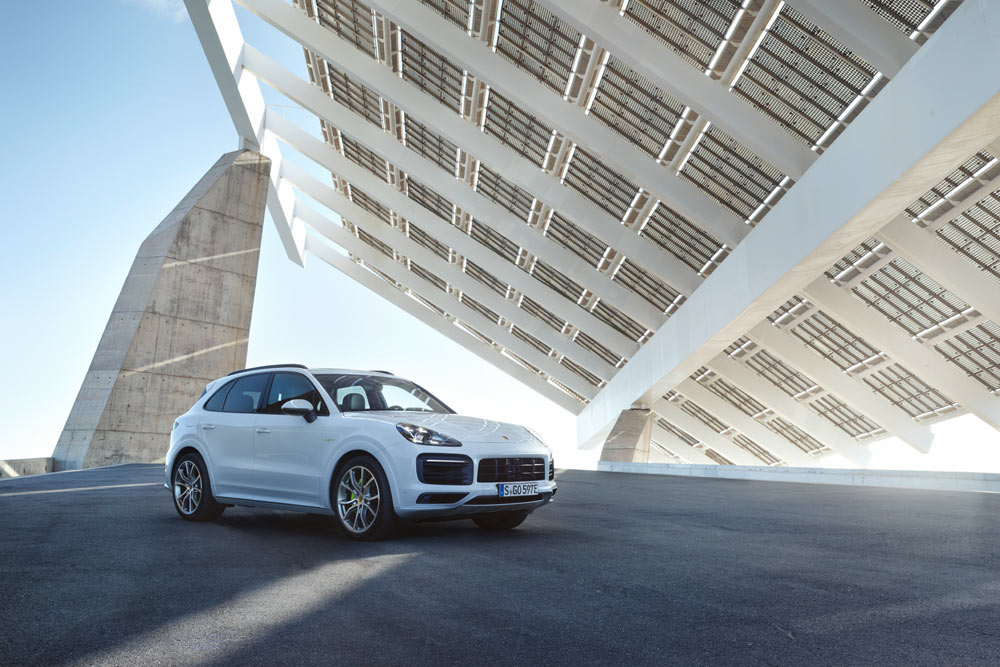Porsche Press Release Database
Current Press releases
New Cayenne now available as a plug-in hybridPorsche SUV with E-performance and new comfort options
Australia.
A three-litre V6 engine (250 kW/340 hp) combines with an electric engine (100 kW/136 hp) to generate system power of 340 kW (462 hp). The maximum torque of 700 Nm is already available just above idling speed; the boost strategy matches that of the 918 Spyder supercar.
The
Alongside the launch of the
462 horsepower system power with 918 Spyder boost concept
The next stage in
The boost strategy derived from the 918 Spyder supercar is a new addition. It ensures that the electric engine can be used in all the standard Sport Chrono Package’s driving modes for an additional performance boost. This means the maximum system torque becomes available as you press the accelerator pedal. Depending on the driving situation and performance requirements, drivers can continue to draw on the boost torque across the entire range of speeds. This leads to a more agile and superior driving experience. The extent of the boost support and battery charging during the journey depend on the driving mode. In the performance-focused Sport and Sport Plus modes, virtually all of the battery's energy can be used for a boost. In Sport mode, the battery is charged just as much as is required for a new boost. In Sport Plus mode, the battery is recharged as quickly as possible. The other modes support maximum driving efficiency.
Battery capacity and charging
Battery capacity has improved significantly in the
The fluid-cooled battery, stored beneath the loading floor in the rear of the car, consists of eight cell modules with 13 prismatic lithium ion cells each. Within 7.8 hours, the high-voltage battery is fully charged via a 230 volt connection with ten amps. If the optional 7.2 kw on-board charger and a 230 volt connection with 32 amps are used as an alternative to the standard 3.6 kw charger, the battery is fully charged again after only 2.3 hours.
Furthermore, the charging process can be monitored via
New hybrid module and rapid switching Tiptronic S
Active hang-on all-wheel drive and 3.5 ton trailer load
With
New options: head-up display and 22-inch light alloy wheels
With the launch of the
Market launch and pricing
The new
Fuel consumption and emissions #
^ The maximum electric range fluctuates between 42 and 44 km depending on the set of tyres used.
* Prices are recommended retail prices before statutory on-road and dealer delivery charges, which vary from State to State.
# Fuel Consumption and emissions
The data presented here was recorded using the Euro 6 test procedure (715/2007/EC, 692/2008/EC, 566/2011/EC and ECE-R 101) and the NEDC (New European Driving Cycle). The respective figures were not recorded on individual vehicles and do not constitute part of the offer. This data is provided solely for the purpose of comparison between the respective models. Fuel consumption was recorded on vehicles with standard specification. Optional equipment may affect fuel consumption and vehicle performance. Fuel consumption and CO2 emissions are not only determined by a vehicle’s fuel efficiency, but also by the driving style, tyre set used and other factors irrespective of vehicle specification.
2/5/2018







![[+]](https://files.porsche.com/filestore/news/australia/none/2018-05-02/headthumbnail1/707baf12-4e9c-11e8-bbc5-0019999cd470/porsche-New-Cayenne-now-available-as-a-plug-in-hybrid.jpg)
![[+]](https://files.porsche.com/filestore/news/australia/none/2018-05-02/headthumbnail2/ec4abb38-4e9c-11e8-bbc5-0019999cd470/porsche-New-Cayenne-now-available-as-a-plug-in-hybrid.jpg)
![[+]](https://files.porsche.com/filestore/news/australia/none/2018-05-02/headthumbnail3/89fd2020-4e9c-11e8-bbc5-0019999cd470/porsche-New-Cayenne-now-available-as-a-plug-in-hybrid.jpg)
![[+]](https://files.porsche.com/filestore/news/australia/none/2018-05-02/headthumbnail4/a675ea4c-4e9c-11e8-bbc5-0019999cd470/porsche-New-Cayenne-now-available-as-a-plug-in-hybrid.jpg)
![[+]](https://files.porsche.com/filestore/news/australia/none/2018-05-02/headthumbnail5/8d0b1d48-4e9d-11e8-bbc5-0019999cd470/porsche-New-Cayenne-now-available-as-a-plug-in-hybrid.jpg)
![[+]](https://files.porsche.com/filestore/news/australia/none/2018-05-02/headthumbnail6/90a0c943-4e9e-11e8-bbc5-0019999cd470/porsche-New-Cayenne-now-available-as-a-plug-in-hybrid.jpg)
![[+]](https://files.porsche.com/filestore/news/australia/none/2018-05-02/headthumbnail7/c024a36f-4e9e-11e8-bbc5-0019999cd470/porsche-New-Cayenne-now-available-as-a-plug-in-hybrid.jpg)